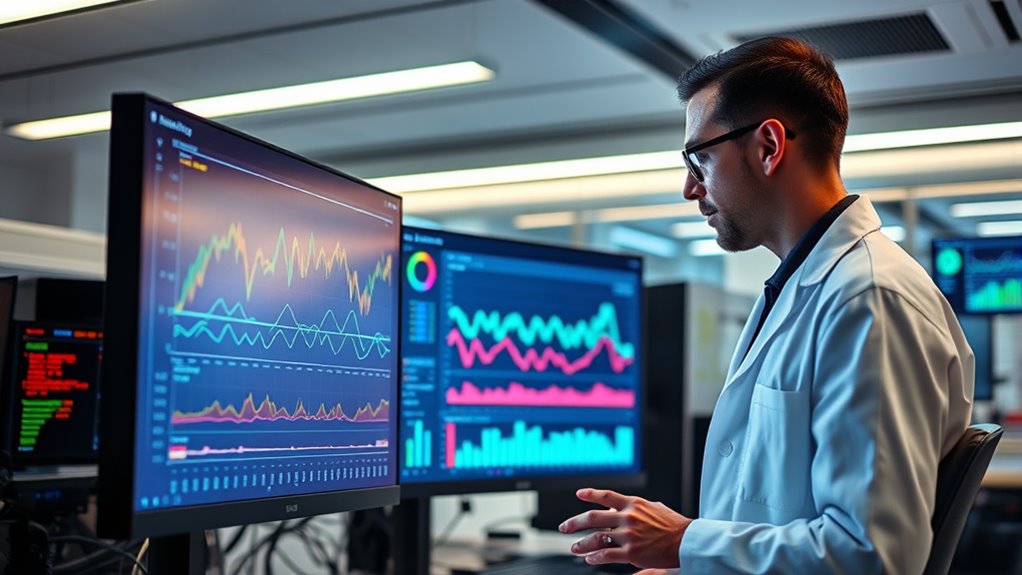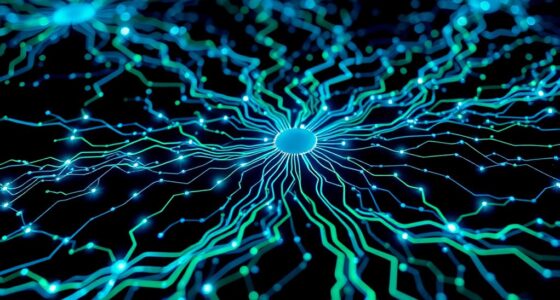Model drift happens when your machine learning model’s performance drops over time due to changes in data or external factors. You can spot it by monitoring input features, prediction consistency, and key metrics like accuracy or error rates. Techniques like performance tracking, statistical charts, and drift detection algorithms help you catch it early. To stay effective, you’ll want to learn about strategies for detection and mitigation—keep going to discover how to keep your models reliable.
Key Takeaways
- Model drift occurs when changes in data patterns cause model performance to degrade over time.
- Types include persistent, sudden, seasonal, and continuous drift, each requiring different detection strategies.
- Indicators like feature divergence and prediction inconsistency signal potential drift.
- Techniques involve monitoring performance metrics, data validation, statistical charts, and drift detection algorithms.
- Early detection and ongoing evaluation enable timely retraining and adjustments to maintain model accuracy.
What Is Model Drift and Why Does It Matter?
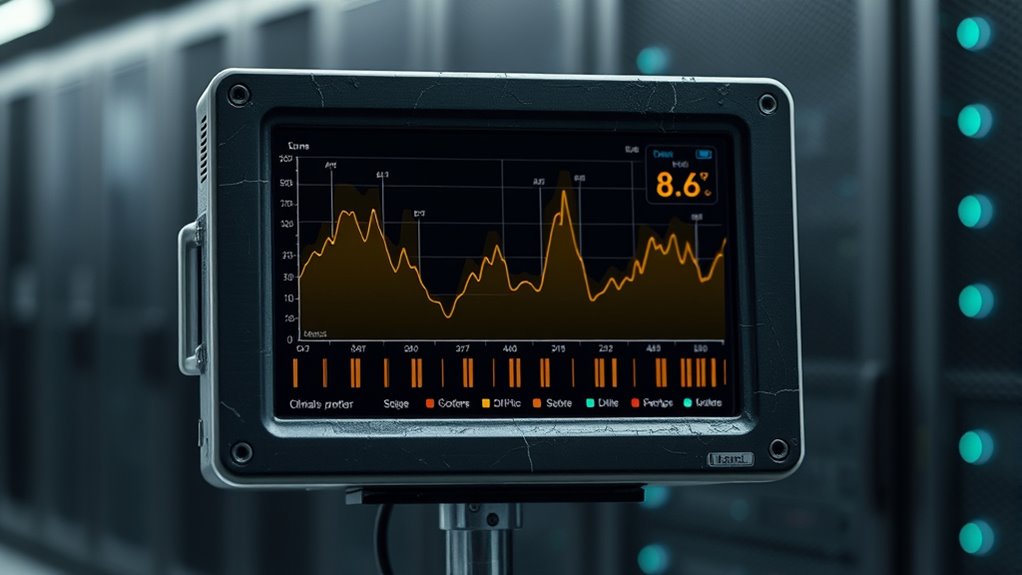
Model drift occurs when a machine learning model’s performance declines over time because the data it encounters changes. This shift can threaten your model’s integrity, leading to inaccurate predictions or decisions. As data evolves, patterns the model relies on may no longer hold, causing performance degradation. Recognizing this drift is vital because it directly impacts the reliability of your model’s outputs. If you ignore model drift, your system might produce outdated or incorrect results, undermining trust and decision-making. Detecting these changes early helps maintain performance and guarantees your model continues to serve its intended purpose effectively. Regularly monitoring data and model outputs allows you to spot signs of drift, layer textures and colors, and preserving your model’s accuracy and safeguarding its overall integrity.
Types of Model Drift: Concept and Examples

Understanding the different types of model drift is essential for effectively maintaining your machine learning systems. Conceptual shifts occur when the underlying assumptions or definitions of your data change over time, leading to model inaccuracies. For example scenarios, a spam detection model trained on specific email patterns may struggle if those patterns evolve. Data drift involves changes in the input data distribution without altering the core concepts, such as a sudden increase in certain customer behaviors. This type affects model performance without changing the data’s meaning. Recognizing these different types helps you identify whether shifts are due to conceptual changes or data variations. By understanding these distinctions, you can implement targeted strategies to detect and address each type of drift effectively. Additionally, monitoring Pimple Patch trends can help identify subtle shifts in data that might indicate emerging issues.
Causes Behind Model Drift in Real-World Scenarios

In real-world scenarios, your model can start to drift because the data it was trained on no longer reflects current conditions. Changes in data distribution or external factors, like new market trends or regulations, can cause this shift. Recognizing these causes helps you take timely action to maintain your model’s accuracy. Additionally, sound vibrations may influence data patterns in certain environments, affecting model performance over time.
Data Distribution Changes
Changes in data distribution are a primary cause of model drift, occurring when the patterns or characteristics of the data you encounter differ from your training data. This can happen if the data’s underlying structure shifts, affecting data consistency and feature stability. When data evolves, your model’s assumptions no longer hold, reducing accuracy. To understand this, consider the following:
| Cause | Impact |
|---|---|
| Seasonal variations | Changes in data patterns over time |
| Sensor malfunctions | Introduces noise, affects features |
| Policy updates | Alters data collection methods |
| Market trends | Shift in data characteristics |
| Data collection changes | New sources or formats introduced |
Monitoring data distribution helps detect these shifts early, ensuring your model remains reliable. Additionally, regular validation against recent data can help identify discrepancies in data, allowing you to take corrective actions promptly.
External Environment Shifts
External environment shifts are significant drivers of model drift because they directly impact the context in which your data is generated. External factors like economic changes, regulatory updates, or technological advancements can alter the data landscape your model relies on. Market dynamics, such as increased competition or shifts in consumer preferences, also influence data patterns. When these external factors change suddenly or gradually, your model may no longer accurately reflect current conditions. This mismatch can cause predictions to become less reliable over time. Monitoring external environment shifts helps you identify when significant external factors or market dynamics are affecting your data. Recognizing these shifts allows you to update or recalibrate your model to maintain its accuracy and relevance in a changing world. Additionally, understanding the creative process involved in adapting to these shifts can foster innovative solutions to maintain model performance.
Indicators That Signal a Model Is Drifting
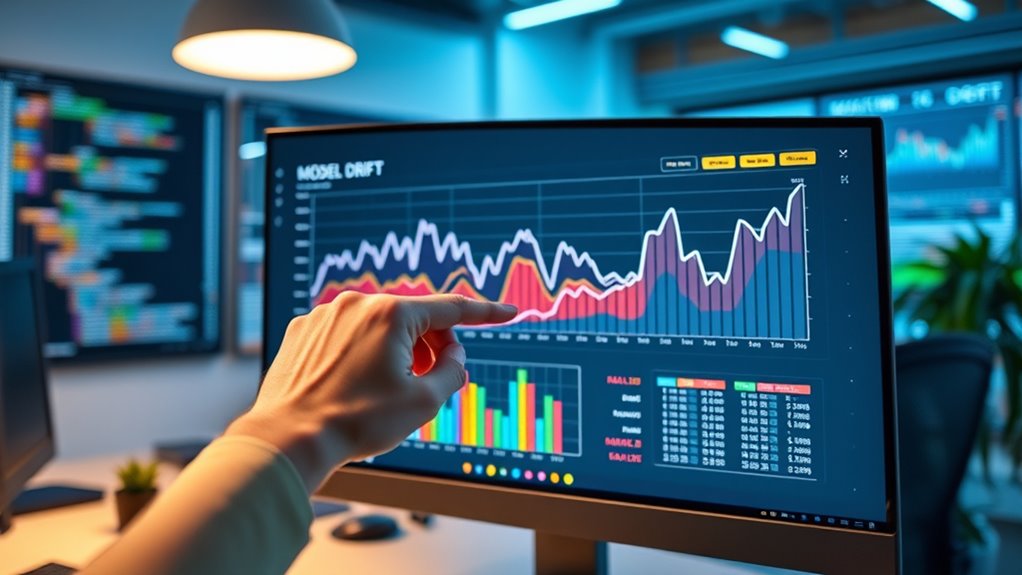
Detecting model drift early relies on recognizing specific signals that indicate your model’s performance or behavior is deviating from expectations. One key indicator is feature divergence, where input data features shift away from the original training data, signaling that the environment has changed. You may also notice prediction inconsistency, where the model’s outputs become less reliable or suddenly vary for similar inputs. These signs suggest your model isn’t aligning with current data patterns, which can lead to decreased accuracy. Monitoring changes in feature distributions and tracking fluctuations in prediction results help you catch drift early. Recognizing these signals allows you to take corrective actions promptly, maintaining your model’s effectiveness and ensuring it continues to serve your needs reliably. Additionally, understanding how model drift impacts your system can help you implement more robust detection strategies.
Techniques to Detect and Monitor Model Drift

To effectively monitor model drift, you should implement various techniques that track data and prediction performance over time. These methods help you identify subtle shifts early, ensuring your model stays accurate. You can use feature engineering to create new indicators reflecting data changes, making drift detection more sensitive. Regularly assess model interpretability to understand how input feature importance evolves, revealing potential issues. Consider techniques like statistical process control charts that monitor data distribution changes, and performance metrics like accuracy or RMSE over time. Additionally, employ drift detection algorithms that compare current predictions with baseline expectations. By combining these approaches, you gain an all-encompassing view of model stability, enabling timely interventions before drift notably impacts your results. Special Events and Themed Breakfasts can also provide insights into shifting community interests and preferences, which may influence data patterns and model performance over time.
Strategies to Mitigate and Adapt to Model Drift
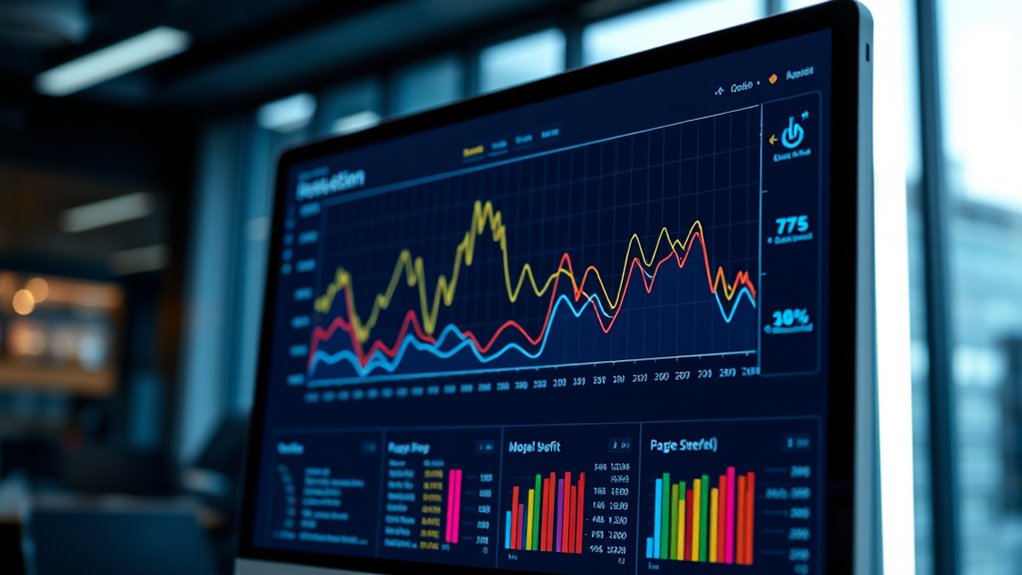
When you recognize that your model is experiencing drift, implementing proactive strategies is essential to maintain its performance. One effective approach is model retraining, which involves updating your model with recent data to adapt to changing patterns. Another key tactic is drift mitigation, where you adjust your data processing or feature engineering techniques to reduce drift impact. To help you choose, consider this table:
| Strategy | Description | When to Use |
|---|---|---|
| Model retraining | Regularly update the model with new data | Persistent drift over time |
| Drift mitigation | Adjust data or features to counter drift effects | Sudden or seasonal drift |
| Model monitoring | Continually observe model performance for signs of drift | Early detection and response |
Additionally, leveraging model evaluation metrics can provide early indications of drift, enabling timely intervention.
Best Practices for Maintaining Model Performance Over Time

Maintaining your model’s performance over time requires proactive strategies and ongoing vigilance. Regular performance monitoring helps you identify when model drift occurs, allowing timely interventions. To keep your model effective, consider these best practices:
- Schedule periodic model retraining with fresh data
- Use automated alerts for performance drops
- Incorporate data validation to detect data quality issues
- Track key performance metrics consistently
- Adjust your model based on performance insights
- Leverage vegetable juices as a metaphor for refreshing data inputs that can help prevent model drift.
Frequently Asked Questions
How Often Should I Check My Model for Drift?
You should check your model for drift regularly, depending on your model update frequency and drift monitoring strategies. For high-stakes applications, consider daily or weekly checks to catch issues early. In less critical cases, monthly reviews might suffice. Consistent monitoring helps you stay ahead of data changes, ensuring your model remains accurate. Adjust your drift detection schedule based on how quickly your data environment evolves and your specific performance goals.
Can Model Drift Occur Without Performance Decline?
Ever wondered if model drift can happen without showing performance decline? It’s possible because drift might impact model stability subtly, without immediately affecting accuracy. You should watch for drift indicators like changing data patterns or feature importance shifts, even if your model’s performance seems steady. Recognizing these signs early helps maintain reliable predictions, preventing unseen issues from escalating. So, yes, drift can occur quietly, emphasizing the importance of monitoring beyond just performance metrics.
What Tools Are Best for Detecting Model Drift?
You should focus on model monitoring and drift detection tools to identify changes in your model’s behavior. Tools like Prometheus, Grafana, and custom dashboards help track key performance metrics over time. Additionally, specialized drift detection tools such as Alibi Detect or Evidently AI can alert you when data distribution shifts happen. Using these tools actively guarantees you catch model drift early, maintaining accuracy and reliability in your predictions.
How Does Data Quality Affect Model Drift?
You might not realize it, but poor data quality can cause chaos in your models! Data contamination and feature inconsistency are like sneaky saboteurs that silently degrade your model’s performance. When your data’s polluted or features change unexpectedly, your model drifts wildly off course, making inaccurate predictions. Keeping your data clean and consistent isn’t just important; it’s the secret weapon to prevent dramatic model drift and maintain reliable results.
Is Model Drift More Common in Certain Industries?
You might notice that model drift is more common in industries facing industry-specific challenges, like finance or healthcare, where rapid changes and complex regulations occur. These sectors often experience regulatory impacts that require frequent model updates, increasing drift risk. Additionally, evolving market conditions and data environments make it harder to maintain model accuracy, so keeping an eye on drift is vital for staying compliant and delivering reliable results in such dynamic industries.
Conclusion
Understanding and detecting model drift is vital to keep your models accurate and reliable. While some might think regular updates are enough, proactive monitoring uncovers subtle shifts before they impact performance. By staying vigilant and using effective techniques, you can adapt quickly and maintain trust in your models. Don’t wait for declining results—embrace ongoing oversight to guarantee your models serve you well over time.
